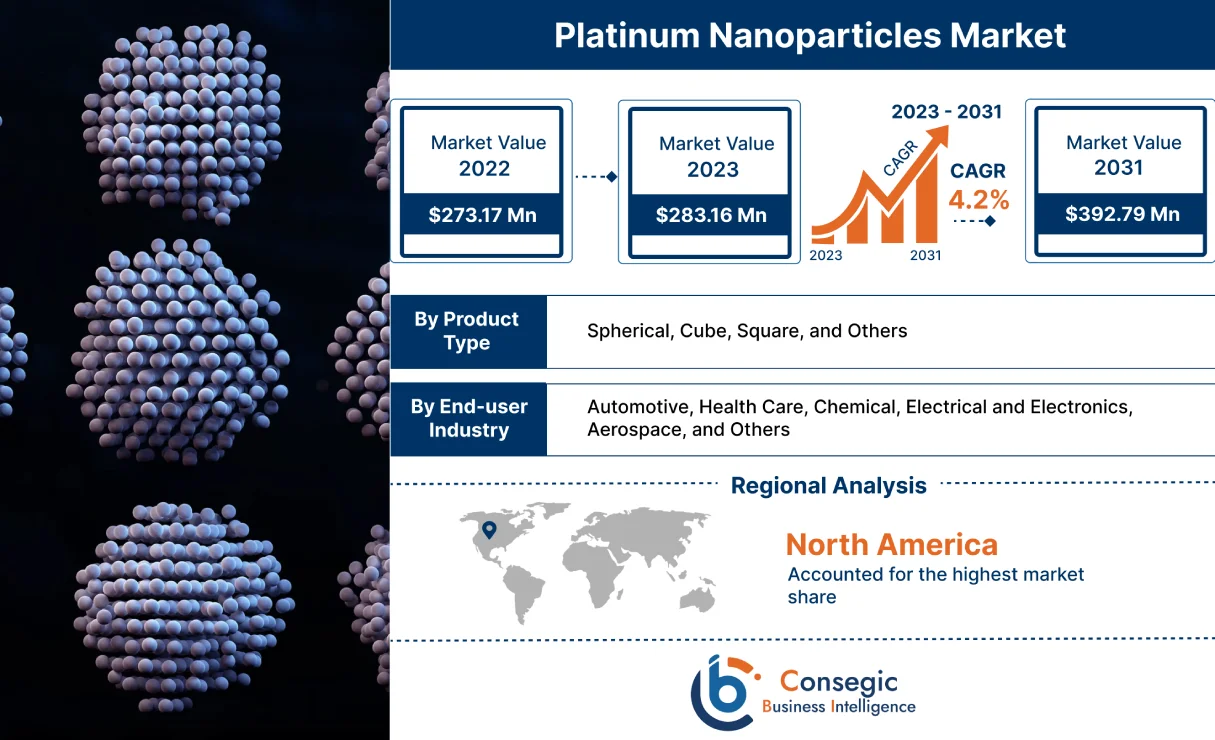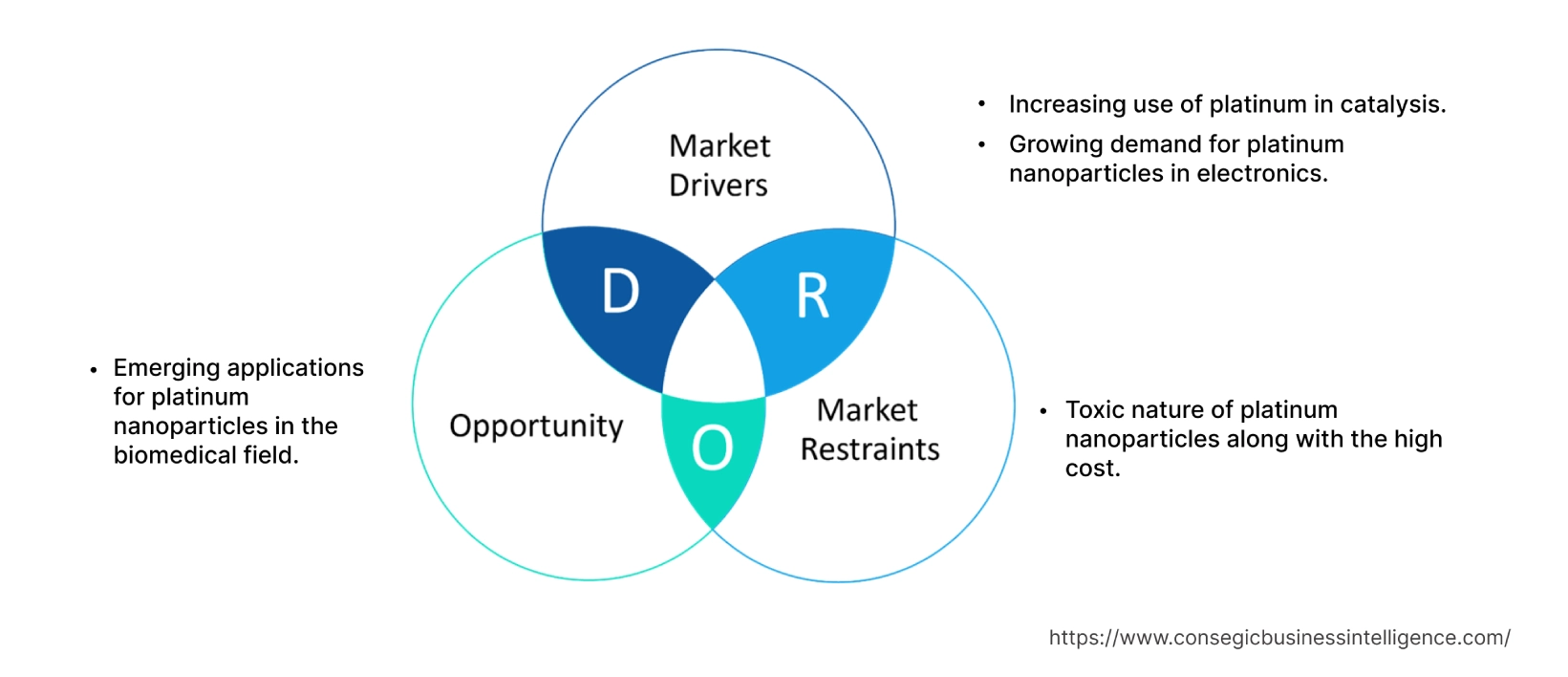Platinum Nanoparticles Market Size :
Consegic Business Intelligence analyzes that the platinum nanoparticles market size is growing with a CAGR of 4.2% during the forecast period (2023-2031). The market accounted for USD 273.17 million in 2022 and USD 283.16 million in 2023, and the market is projected to be valued at USD 392.79 Million by 2031.
Platinum Nanoparticles Market Scope & Overview:
Platinum nanoparticles are extremely small particles of platinum metal, typically measuring between 1 and 100 nanometers in diameter. They are typically synthesized by reducing platinum ions in solution with a stabilizing or capping agent. This process can be carried out using a variety of methods, including chemical reduction, electrochemical reduction, and photochemical reduction.
These nanoparticles have several unique properties that make them useful in a wide range of applications. For example, they are highly catalytic, meaning that they can speed up the rate of chemical reactions. They are also very good at absorbing and scattering light, which makes them useful in optical applications. Additionally, these compounds are non-toxic and biocompatible, making them suitable for use in biological and medical applications.
Platinum Nanoparticles Market Insights :
Platinum Nanoparticles Market Dynamics - (DRO) :
Key Drivers :
Increasing use of platinum in catalysis
The increasing use of platinum in catalysis is driving the requirement for platinum nanoparticles industry. These nanoparticles are highly catalytic which can help to speed up the rate of chemical reactions. This makes them ideal for use in a variety of catalytic applications, such as automotive catalytic converters, petrochemical cracking catalysts, and fuel cell catalysts. Platinum is a key component of automotive catalytic converters. Catalytic converters are devices that convert harmful exhaust emissions from vehicles into less harmful gases. This helps to reduce air pollution and improve air quality.
As per the analysis, these nanoparticles are used in catalytic converters because they are highly catalytic. This makes them ideal for converting harmful exhaust emissions into less harmful gases. Significant development in the production of automotives across the globe is driving the demand for automotive catalytic converters. For instance, according to the report by the European Automobile Manufacturer's Association in February 2023, car production in the Europe region increased by 7.1% in 2022. Thus, the significant development in the production of automobiles across the various regions worldwide is driving the platinum nanoparticles market trend for the manufacturing of automobile catalytic converters and driving the market trends.
Growing demand for platinum nanoparticles in electronics
These nanoparticles have high electrical conductivity, making them ideal for use in electrical contacts and interconnects. This is because these nanoparticles have a large surface area, which allows them to efficiently conduct electricity. The nanoparticles have high thermal conductivity, making them ideal for use in heat sinks and other thermal management applications. This is because these nanoparticles can efficiently transfer heat away from electronic components, preventing them from overheating. Furthermore, as per the analysis, these particles are highly chemically stable, making them resistant to corrosion and other environmental degradation. This is important for electronic components, which must be able to operate reliably in a variety of environments.
As per the analysis, the increasing government initiatives for the development of electronics production across their countries are driving platinum nanoparticles market demand for electronics across the globe. For instance, in July 2022, the Indian Ministry of Electronics and IT announced the flagship Production Linked Incentive (PLI) Schemes for the promotion of manufacturing of electronic components and semiconductors, modified electronics manufacturing cluster (EMC 2.0) Scheme are major step towards making India "AtmaNirbhar" in electronics manufacturing. Thus, the increasing government initiatives for the development of electronic production are driving the trends and demand for these nanoparticles across the globe.
Key Restraints :
Toxic nature of platinum nanoparticles along with the high cost
These nanoparticles have been shown to be toxic to both humans and the environment. When inhaled, these nanoparticles can accumulate in the lungs and other organs, leading to a variety of health problems, such as inflammation, fibrosis, and cancer. These nanoparticles also contaminate water and soil, harming aquatic life and plants. The toxicity of these nanoparticles is limiting the adoption of these particles in new applications. Many companies are hesitant to invest in new products that use these nanoparticles, due to the potential health and environmental risks, as well as the high cost.
Moreover, as per the analysis, the toxic nature and high cost of these nanoparticles are making it difficult for the existing nanoparticle manufacturers to compete with other manufacturers of nanomaterials. For example, silver nanoparticles and gold nanoparticles are less expensive and less toxic than these nanoparticles, and they are finding increasing use in a variety of applications. Thus, the high price and environmental hazards proposed by these nanoparticles are restraining the market across the globe.
Future Opportunities :
Emerging applications for platinum nanoparticles in the biomedical field
Emerging applications for these nanoparticles in the biomedical field are providing lucrative trends and global platinum nanoparticles market opportunities. These compounds are being used to develop new and innovative treatments for a variety of diseases, including cancer, infections, and neurodegenerative disorders. One of the most promising emerging applications for these nanoparticles is in cancer treatment. Based on the analysis, these nanoparticles are used to deliver chemotherapy drugs directly to cancer cells while minimizing damage to healthy cells. This is because these nanoparticles are targeted to cancer cells using specific antibodies or other ligands.
These nanoparticles are also being used to develop new photothermal therapy treatments for cancer. In photothermal therapy, these nanoparticles are injected into the body and then irradiated with light. The light heats up the nanoparticles, which kill the surrounding cancer cells. Another emerging application for these nanoparticles is in the treatment of infections. As per the analysis, these nanoparticles are used to develop new antibiotics and antifungal drugs that are more effective and have fewer side effects than traditional antibiotics. These nanoparticles can also be used to develop new vaccines that are more effective at preventing infections. The increasing prevalence of cancer is increasing the requirement for effective cancer therapies across the globe. For instance, according to the report by the National Center for Biotechnology Information in January 2023, the global number of cancer deaths is increasing as the world population grows and ages. In 2023, 1,958,310 new cancer cases and 609,820 cancer deaths are projected to occur in the United States. Thus, the emerging applications of these compounds in biomedical applications is expected to provide lucrative opportunities and trends in the market over the forecast period.
Platinum Nanoparticles Market Report Insights :
| Report Attributes | Report Details |
| Study Timeline | 2017-2031 |
| Market Size in 2031 | USD 392.79 Million |
| CAGR (2023-2031) | 4.2% |
| By Product Type | Spherical, Cube, Square, and Others |
| By End-user Industry | Automotive, Health Care, Chemical, Electrical and Electronics, Aerospace, and Others |
| By Region | North America, Europe, Asia-Pacific, Latin America, and Middle East & Africa |
| Key Players | American Elements, HiQ-Nano s.r.l., Meliorum Technologies, Inc., Metrohm India Limited, NanoBio Chemicals India Pvt. Ltd., NANOCHEMAZONE, Nanocomposix, Nanoshel LLC, Particular GmbH, PlasmaChem GmbH, Sigma-Aldrich, Stream Chemicals, Inc., and TANAKA HOLDINGS Co., Ltd |
| Geographies Covered | |
| North America | U.S. Canada Mexico |
| Europe | U.K. Germany France Spain Italy Russia Benelux Rest of Europe |
| APAC | China South Korea Japan India Australia ASEAN Rest of Asia-Pacific |
| Middle East and Africa | GCC Turkey South Africa Rest of MEA |
| LATAM | Brazil Argentina Chile Rest of LATAM |
| Report Coverage | Revenue Forecast, Competitive Landscape, Growth Factors, Restraint or Challenges, Opportunities, Environment & Regulatory Landscape, PESTLE Analysis, PORTER Analysis, Key Technology Landscape, Value Chain Analysis, Cost Analysis, and Regional Trends & Forecast |
Platinum Nanoparticles Market Segmental Analysis :
By Product Type :
The product type is categorized into alloy spherical, cube, square, and others. In 2022, the spherical segment accounted for the highest platinum nanoparticles market share of 35.37% in the platinum nanoparticles market. Spherical platinum nanoparticles are the most common type of platinum nanoparticle. They are relatively easy to produce and have the most consistent properties. These are used in a wide range of applications, including catalysis, fuel cells, and electronics. They are very effective catalysts. They can be used to accelerate a variety of chemical reactions, including fuel cell reactions, petrochemical reactions, and pharmaceutical reactions. They are used as catalysts in fuel cells to produce electricity from hydrogen and oxygen. A significant rise in the production of fuel cells across the globe is driving the segment development across the globe. For instance, in March 2023, Japan's Honda Motor Co (7267.T) announced that they would start producing a new hydrogen fuel cell system jointly developed with General Motors Co. in 2023, in a bid to expand its hydrogen business. Thus, the growing initiative for the development of fuel cells is driving trend of the segment.
Moreover, the cube segment is expected to hold the highest CAGR over the forecast period. Cube nanoparticles have a unique cubic shape. They have a high surface area and can self-assemble into ordered structures. Cube nanoparticles are finding increasing use in catalysis, and biosensors. Furthermore, they are very effective catalysts. They can be used to accelerate a variety of chemical reactions, including fuel cell reactions, petrochemical reactions, and pharmaceutical reactions. The increasing requirement for these nanoparticles for catalytic applications and petroleum applications is expected to provide lucrative trends for the segment development worldwide.
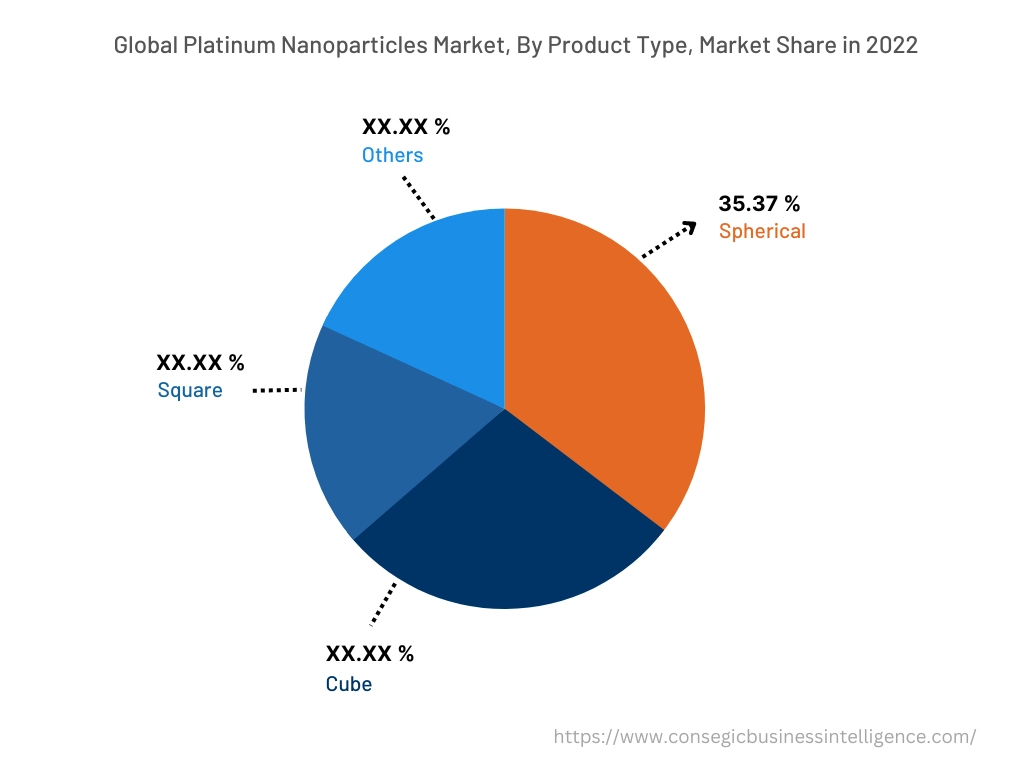
By End-User :
The end-user industry segment is categorized into automotive, health care, chemical, electrical and electronics, aerospace, and others. In 2022, the health care segment accounted for the highest market share in the overall platinum nanoparticles market, and it is also expected to hold the highest CAGR over the forecast period. In the healthcare sector, these nanoparticles have a wide range of potential applications in the healthcare sector for drug delivery, cancer treatment, developing antimicrobial therapies, treatment of neurodegenerative disorders, and other diagnostic applications. These nanoparticles are being used to develop new and innovative treatments for cancer, including targeted drug delivery, photothermal therapy, and immunotherapy. Based on the platinum nanoparticles market analysis, the increasing prevalence of cancer across the globe is driving the demand for these across the globe. For instance, according to the data published by the World Health Organization in February 2022, Cancer is a leading cause of death worldwide, accounting for nearly 10 million deaths in 2020. The most common in 2020 in terms of new cases of cancer were breast 2.26 million cases lung 2.21 million cases. Thus, the significant growth and demand for these nano particles from health care is driving the segment growth across the globe.
By Region :
The regional segment includes North America, Europe, Asia Pacific, the Middle East and Africa, and Latin America.
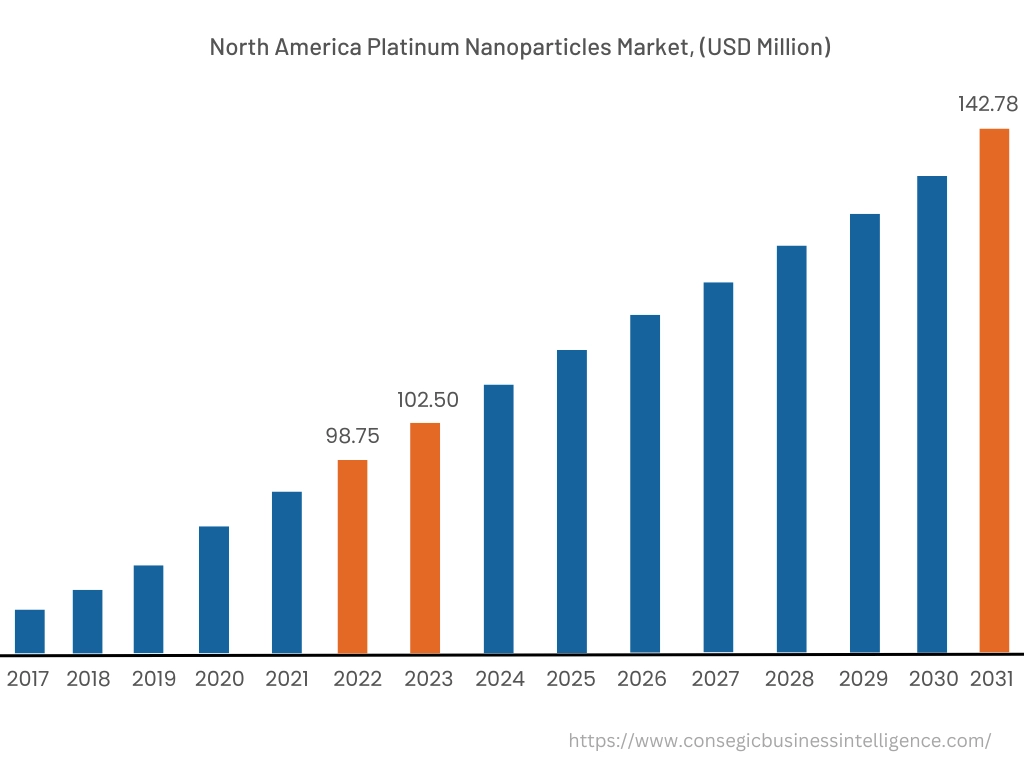
In 2022, North America accounted for the highest market share at 36.15% valued at USD 98.75 Million in 2022 and USD 102.50 Million in 2023, it is expected to reach USD 142.78 Million in 2031, and it is also the fastest growing region across the globe. In North America, the U.S. accounted for the highest market share of 62.23% during the base year of 2022. These nanoparticles are being used to develop new catalytic converters, fuel cells, and batteries. For example, these nanoparticles are being used to develop new catalytic converters that are more effective at reducing emissions from cars and trucks. The increasing production of fuel cells across the region is driving market growth across North America. For instance, in October 2023, Nikola Corporation celebrated the commercial launch of the Nikola Tre FCEV, a hydrogen fuel cell electric truck. The ceremony was held at Nikola's manufacturing facility in Coolidge, Arizona. Thus, the growing focus on the development of fuel cell vehicles and the growing healthcare sector across the region are driving the market growth in North America.
Furthermore, Asia Pacific is expected to witness significant growth over the forecast period, growing at a CAGR of 4.6% during 2023-2030. Significant growth in electronics production across the Asia Pacific is improving the demand for these nanoparticles across the region. For instance, according to the report by the Government of China in March 2022, China's electronics manufacturing sector maintained steady expansion during the first two months of the year, with the added value of major electronics manufacturers rising 12.7% year-on-year, compared with the 7.5% growth seen in the overall industrial sector. Thus, the significant platinum nanoparticles market growth in the electronics sector across the Asia Pacific region is expected to create lucrative opportunities and trends for the platinum nanoparticles market in the Asia Pacific region.
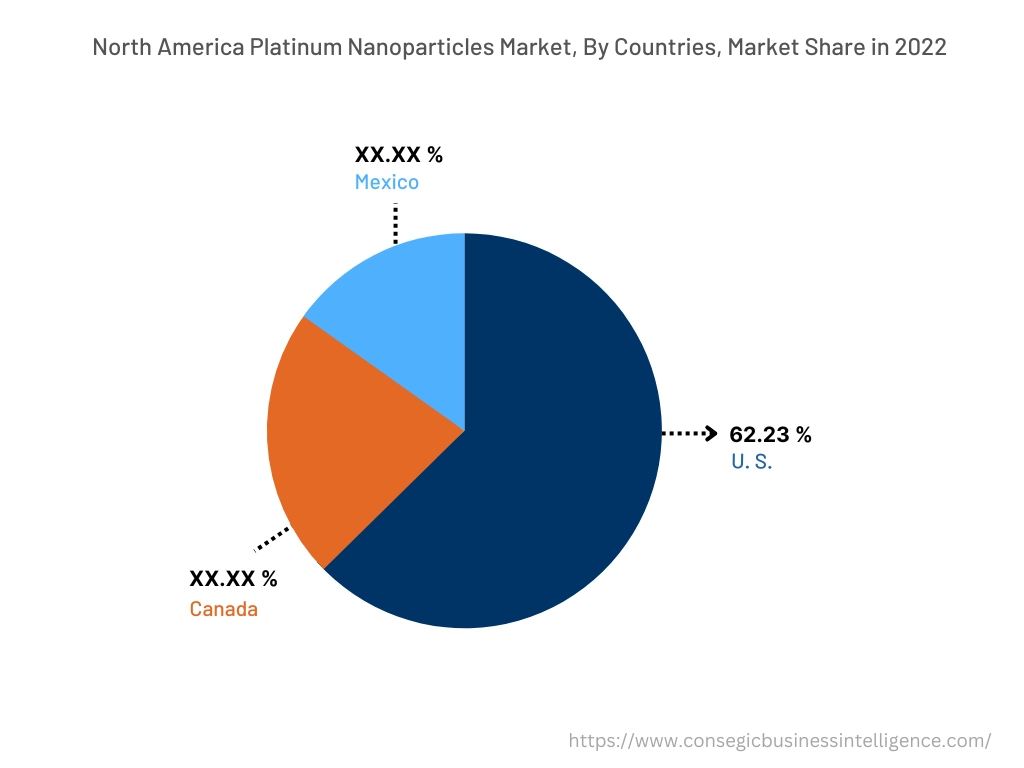
Top Key Players & Market Share Insights:
The platinum nanoparticles market is highly competitive, with several large players and numerous small and medium-sized enterprises. These companies have strong research and development capabilities and a strong presence in the platinum nanoparticles market through their extensive product portfolios and distribution networks. The market is characterized by intense competition, with companies focusing on expanding their product offerings and increasing their platinum nanoparticles market revenue through mergers, acquisitions, and partnerships. The key players in the market include-
- American Elements
- HiQ-Nano s.r.l.
- PlasmaChem GmbH
- Sigma-Aldrich
- Stream Chemicals, Inc.
- TANAKA HOLDINGS Co., Ltd
- Meliorum Technologies, Inc.
- Metrohm India Limited
- NanoBio Chemicals India Pvt. Ltd.
- NANOCHEMAZONE
- Nanocomposix
- Nanoshel LLC
- Particular GmbH
Recent Industry Developments :
- In March 2022, NanoComposix launched a new production site for platinum nanoparticles in South Korea. The new site will produce a variety of platinum nanoparticle products, including catalysts, fuel cell electrodes, and battery materials.
- In July 2022, Japanese company Tanaka Kikinzoku Kogyo which is a subsidiary of TANAKA HOLDINGS Co., Ltd. expanded its business of platinum nanoparticles by acquiring US-based company Nanophase Technologies. This acquisition will give Tanaka Kikinzoku Kogyo access to Nanophase Technologies' expertise in the synthesis and processing of these nanoparticles.
Key Questions Answered in the Report
What was the market size of the platinum nanoparticles market in 2022? +
In 2022, the market size of platinum nanoparticles was USD 273.17 million.
What will be the potential market valuation for the platinum nanoparticles industry by 2031? +
In 2031, the market size of platinum nanoparticles will be expected to reach USD 392.79 million.
What are the key factors driving the growth of the platinum nanoparticles market? +
Increasing use of platinum in catalysis across the globe is fueling market growth at the global level.
What is the dominant segment in the platinum nanoparticles market for the product type? +
In 2022, the spherical segment accounted for the highest market share of 35.37% in the overall platinum nanoparticles market.
Based on current market trends and future predictions, which geographical region is the dominating region in the platinum nanoparticles market? +
North America accounted for the highest market share in the overall market.
